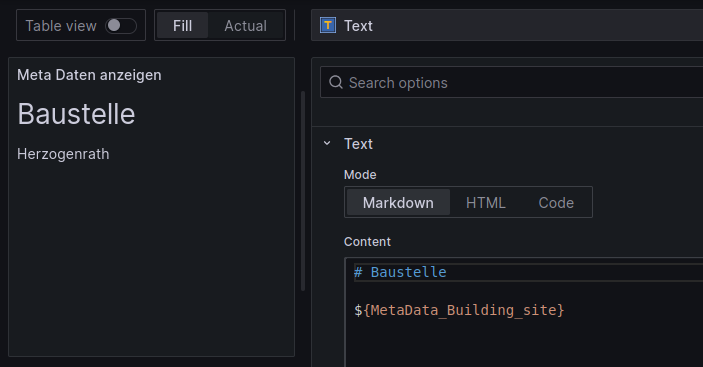v5.3 - 02.2025
Dashboard extension
A reference to the machine has been added to the Dashboards object. This makes it possible to reference dashboards directly to a machine, which is important for the new feature "extended machine location change". It is also possible to detach a dashboard from its template. The dashboard template then no longer has any influence on the dashboard.
Dashboards that are attached to a dashboard template can now be easily updated by clicking on .
The following attributes have also been added to the Grafana dashboards:
- startMode: Describes how the dashboard is opened in Grafana (Kiosk, TV, Editor)
- visibility: Describes where the dashboard is displayed in the m2v (Mobile Overview / Mobile Details / Portal / Settings)
For dashboards that are attached to a machine, it is now possible to display the machine's metadata via a variable in the Grafana dashboard. The schema ${MetaData_ENGLISCHER_KEY} is used for this, where ENGLISCHER_KEY must be replaced with the English translation of the MetaData definition.

Global rollout
The procedure for the global rollout of a dashboard template has been optimized. Now, when you click on " Global rollout", you can decide whether only existing dashboards should be updated or whether new dashboards should also be created.
This function now also exists in the machine context. The dashboards of a machine can be updated and/or created by clicking on :custom-global-rollout-dashboard:.
extended machine location change
With the extended machine location change, it is possible to leave the machine (including its data, dashboards, reports) at its old location as a "historical" machine. However, the dashboards and reports that are referenced to the machine can be copied or regenerated for the new "live" / machine at its new location.
The following configuration options are available:
- Save historical data at old location?
- No → Old location change
- What happens to the data?
- Delete all data
- Keep all data
- Delete data up to a certain point in time
- What happens to the dashboards?
- No dashboards
- Copy dashboards (all dashboards are copied to the new location)
- Regenerate dashboards (only dashboards that are attached to a dashboard template are transferred to the new location)
- What happens to the reports?
- No reports
- Copy reports
- What happens with alerting?
- No alerting
- Default settings of the machine template
- Copy alerting of the machine
- What happens to the data?
- Yes → New machine, old data remains
- What happens to the dashboards?
- No dashboards
- Copy dashboards (all dashboards are copied to the new location)
- Regenerate dashboards (only dashboards that are attached to a dashboard template are transferred to the new location)
- What happens to the reports?
- No reports
- Copy reports
- What happens with alerting?
- No alerting
- Default settings of the machine template
- Copy alerting of the machine
- What happens to the dashboards?
- No → Old location change
Report templates
A new object Report Templates has been introduced to simplify the creation of reports. This makes it possible to create templates for reports, frequently used settings, such as the time span of the data, the task planning and report variables, to be defined once in order to use them later for the creation of a report. to use them later when generating a report.
sequenceDiagram
participant Machine
participant User
participant AuthService
participant m2v
participant MQTTBroker
Machine->>MQTTBroker: CONNECT
Machine->>MQTTBroker: PUBLISH
User->> AuthService: POST /token (API-Key / Credentials)
AuthService-->>User: Access Token
User->>m2v: GET access data for the MQTT broker
m2v-->>User: Access data for the MQTT broker
User->>MQTTBroker: CONNECT (with access data)
User->>MQTTBroker: SUBSCRIBE
MQTTBroker-->>User: PUBLISH (sensor data from machine)